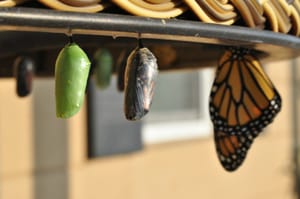Science communication refers to sharing and raising awareness about scientific discoveries to a broad audience. Although many scientists engage broad audiences, not all scientists feel this is an important aspect of their job. However, all scientists should be science communicators. In fact, the importance of engaging a wider audience is part of the National Science Foundation’s statement on broader impacts, since science communication helps strengthen society’s understanding and trust in science. Still, many scientists are often at a loss for how to get started in science communication. Here we draw upon our experiences and provide actionable items for readers to help disseminate science or strengthen their science communication skills.
A positive and inclusive tone helps broaden the reach of science in society.
The first step in becoming a science communicator is considering what type of voice you’d like to have and how that message will connect you with your audience. When considering your options, it is essential to stay true to who you are and let your passion excite others. Also, consider what tone of voice you want to use. A positive and inclusive tone helps broaden the reach of science in society.
Another key aspect of science communication is a classic proverb: know your audience. Science communication is a two-way street, and ensuring communication is flowing in both directions is essential. Without communication between the speaker and listener, it will be unclear or even unlikely that information is successfully shared. Lastly, let your science voice grow as you grow. If passions change, let your voice change with it; if your primary audience changes, let your voice change accordingly.
We encourage you not to shy away from the challenge of trying a new type of science communication, you will find it is a very rewarding experience!
Next, decide which avenue of science communication best suits your voice, skill set, and target audience. Luckily, there are a plethora of platforms to engage with broad audiences. Some platforms will feel more natural given the skills you already have, while others will be difficult to learn. Regardless, we encourage you not to shy away from the challenge of trying a new type of science communication, you will find it is a very rewarding experience!
Although many early career scientists wish to engage in science communication, they don’t know where to start. The remainder of this article is dedicated to discussing ways to become a science communicator, from platforms with low time commitments to more involved methods. Our non-exhaustive list features social media, popular science writing, and in-person engagements.
A surprising amount of science communication happens on Twitter, a powerful social media platform. Twitter is an excellent platform to share ideas, maintain large communities and participate and engage in support networks. Twitter contains a lot of content and may be overwhelming when starting out on the platform. To help you start on your journey, we have compiled some great references to get you started on Twitter-based science communication.
Twitter hashtags are a way to parse through content and identify topics that may be interesting. Looking at hashtags such as #AcademicChatter and #AcademicTwitter may help you to find your voice or the target audience for your platform. Specific topics are accompanied with hashtags such as #WomeninSTEM, #AcademicMentalHealth, #SciComm, or #WomenwhoCode. These hashtags allow scientists to engage others on their platform or can be used in your own platform when tweeting and typically increase the engagement of posts. You can also choose several topics to focus on, such as women in STEM, mental health, and equity in STEM. Focusing on these topics can help to guide your audience to topics which you enjoy and want to engage in.
A tried-and-true form of science communication is popular science writing. Numerous platforms exist for publishing science communication articles, including The Conversation, Massive Science, TheScienceBreaker, and of course ECRLife! Typically, each platform has a process wherein science writers submit article pitches which describe the main messages of their proposed article. If accepted, the writer then submits the full article to the platform, and the authors work with the editor to clarify any language that may be too jargony for a particular platform’s typical audience. Prior to submitting a pitch, it is advisable to read articles from your target platform. This will help you craft your pitch and determine if your article is a good fit.
Other forms of science communication take place in person. Volunteer opportunities associated with established events are the easiest way to get involved in person. Such events are regularly happening at local science centers or community centers. Similarly, international groups such as Pint of Science organize science talks at breweries and similar settings. These activities provide great opportunities to interact with broad audiences in a casual setting. Groups that serve the local community like the Nashville Science Club also organize similar events, so be sure to check what local groups are doing in your community!
Another popular way to engage with the broader community is through your local public library. Libraries are often welcoming to working with student-led organizations from local schools, so feel free to reach out to your local library! One example from Nashville, TN is organized by the Vanderbilt University Chapter of the American Society of Microbiology Vanderbilt Science Club at the Nashville Public Library. These monthly activity-based events are organized for kids under the age of 12, and organizers often found themselves answering more questions from parents while the children were busy with the various activities.
Our recommendations for building your science communication voice and suggested platforms can serve as an outline for a lifelong career in science communication. Taken together, we suggest that social media, online publishing platforms, and in person engagements are effective mediums to bridge the gap between scientists and the broader community. Being a voice of positivity and inclusivity is not only socially responsible, but will help foster a healthy relationship between you as a science communicator and your audience.
About the authors:
Both Jacob L. Steenwyk (https://jlsteenwyk.com), a PhD candidate at Vanderbilt University, and Michelle Jonika (https://michellejonika.github.io), a PhD candidate at Texas A&M, study evolutionary genomics and are passionate about diversity and inclusion. Follow Jacob and Michelle on Twitter @jlsteenwyk , @michellejonika.







